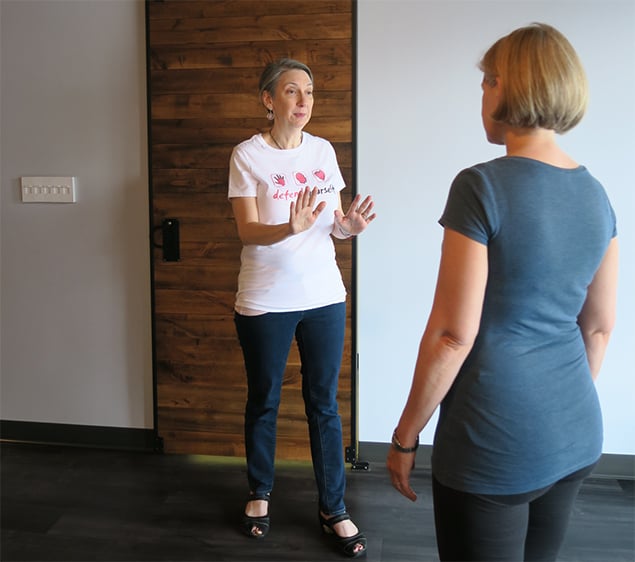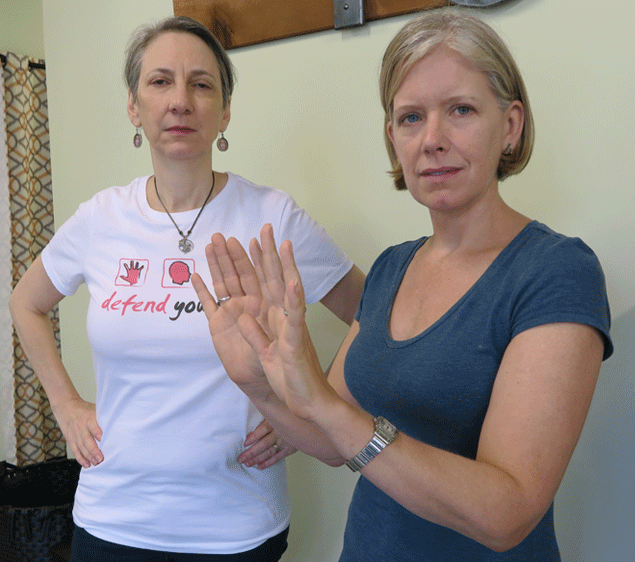Country-music singer Brandi Carlile performs tonight at Wolf Trap, but she’ll be sticking around Washington this weekend—in spirit, at least—when her Fight the Fear campaign sponsors a free self-defense workshop Saturday at the Calvary Baptist Church on 8th St., Northwest.
The class will be led with local anti-harassment group Defend Yourself, which teaches church groups, students, and corporate audiences skills for stopping harassment, assault, and abuse.
“I believe that every issue that gets us closer to justice and equality is important, and for me, you have to start with the body,” says the group’s founder, Lauren Taylor. “If you can’t feel safe in your own body, it’s hard to move forward with anything else.”
Taylor promotes the holistic side of self-defense, and recommends six techniques to practice at home.
“Physical defense and physical strikes are only one part of what it is,” Taylor says. “We deal with everything from prevention and avoidance, understanding where the risks lie, to lots of things that come under the heading of verbal self-defense, whether that’s assertiveness and boundary-setting or de-escalation.”
Practice Saying “No”

Taylor, who studied sociology, says that saying “no” can be difficult for women and young girls who are socialized to place other people’s needs above their own. They practice saying “no” to an attacker, and then broaden it to facing other limitations and vocalizing wants.
“I believe you can’t say an authentic, meaningful ‘yes’ to anything until you can say a ‘no,’ because if you don’t have the capacity to honestly and directly say ‘no,’ then all your ‘yes’s are tainted by the fact that you don’t really have a choice,” she says.
Working with high-school girls, we found boundary-setting decisions extended beyond sexual assault, but also to their bodies and how they treated them, whether that’s eating disorders, or decisions around drugs and drinking, says Stephanie Olson, who was one of the founders of the Empower Program in 1994 to prevent gender-based violence and worked with it for ten years before it closed.
HOW TO DO IT: Check in with yourself daily during your free time, and identify what you are feeling, says Taylor. If you can’t name sadness or anxiety, for example, try identifying physical reactions, such as a clenched jaw or tightened muscles. This exercise will build recognition between you and your intuition, which will make for a faster response time in stressful situations, Taylor says. Practice saying “no” and conveying what you want in different ways: “Don’t come closer”; “get off the bed”; “don’t touch me”; “I don’t want to.” Say them at different intensity levels. Telling your friend you don’t want to go to the movies and telling an attacker you don’t want to get in the car merit different tones, says Taylor.
Stomp on Their Foot

“Almost anyone can do this because it doesn’t take a lot of power,” says Taylor. “There are 26 little bones in your foot. If you break anyone’s little bones, they won’t be able to run after you.
This move can be used in almost any position—in an attack from behind, in a chokehold—and mostly everyone from small children to some handicapped people can do it.
HOW TO DO IT: Keep your hands up. This gives you the ability to protect your face, hit someone, and it communicates that you want them to stop. Take your whole foot and stomp on theirs, aiming for the instep (where the laces would be). Land with your knees bent. This ensures you are dropping all your weight into the person, and it protects your knees. Don’t be afraid to use the attacker for balance. Practice endless combinations until you can quickly read where the openings are no matter your relation to the attacker.
Use a Hammer Fist

HOW TO DO IT: Create a fist and swing downwards, as if hammering a nail. Use it on the nose, either temple, or in the throat. If you’re reach is limited, use a hammer fist on the knee or instep.
Get Out of a Wrist Grab

A wrist grab is a great way to practice all your moves, says Taylor. From there, you can get comfortable with elbow strikes, groin kicks, and more.
HOW TO DO IT: As if painting a circle, move your arm in a circular motion. Contrary to instinct, you want to lean in while doing this for more power as opposed to pulling away, which could cause you to hurt yourself. (A common mishap is hitting oneself in the face while pulling away, due to the momentum of one’s arm.)
Ask for Help

“This is the most underused self-defense technique,” says Taylor. “You don’t think about what resources you have around you, including people.”
HOW TO DO IT: In the moment of an attack or emergency, identify a specific person and tell them what to do. For example, “You in the gray tank, call 911.” Calling out a specific person helps avoid the bystander effect, in which witnesses perceive less responsibility if there are others available to help.
After the attack, it’s important to have someone to talk to for long-term health. Create a resource list, and be able to identify at least two adults that you could talk to freely about your concerns.
Taylor says 100 people have signed up for the class so far, but there is no attendance cap. Defend Yourself will lead the self-defense workshop for women and LGBT people from 2-4 PM at the Calvary Baptist Church (733 8th Street, Northwest), with an additional hour of instruction for LGBT participants. Defend Yourself will be registering people for the class at Carlile’s concert tonight, and on its website.


















